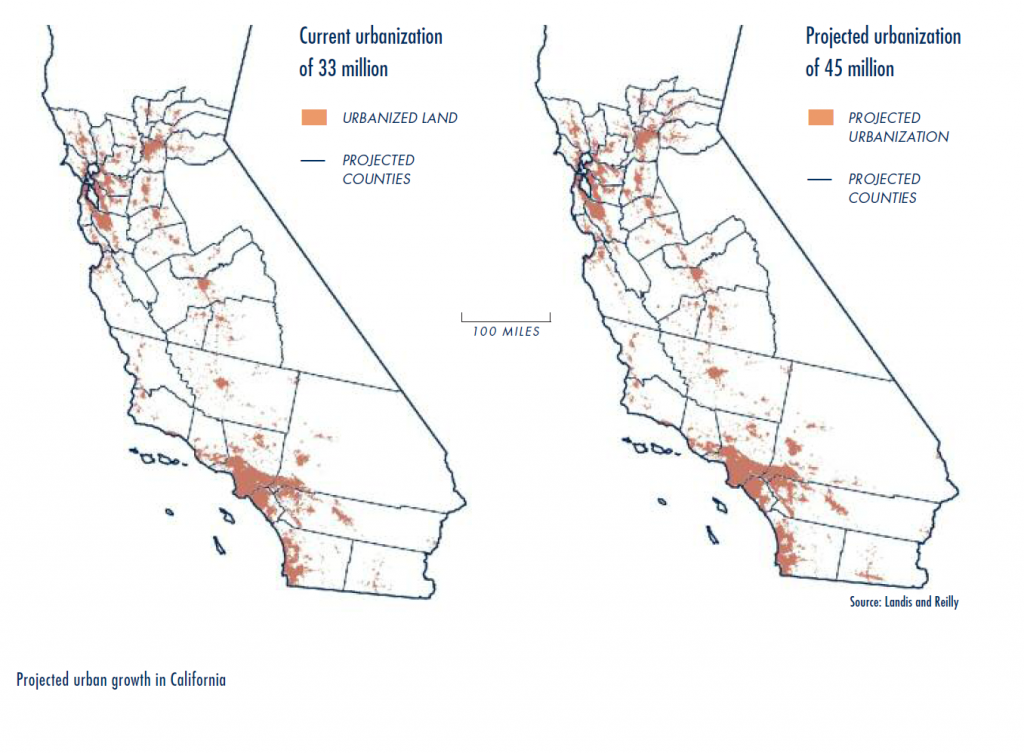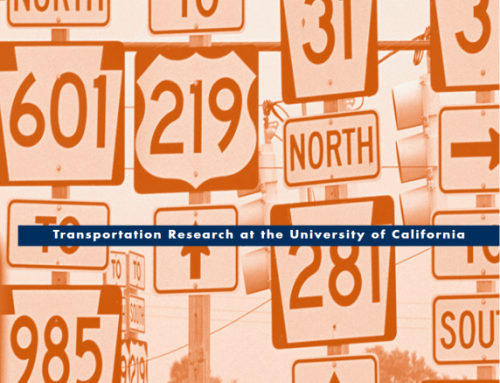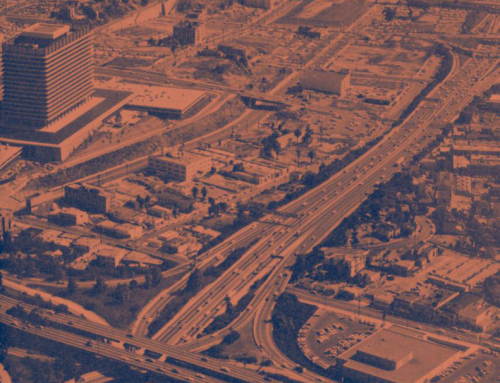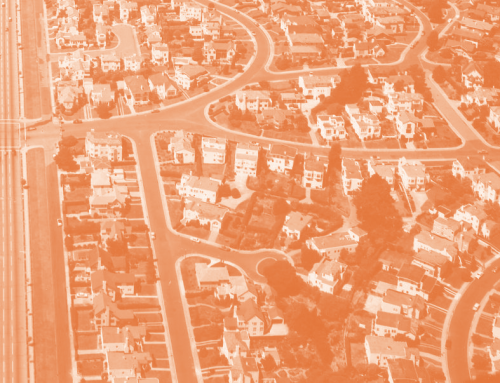Sometime between 2025 and 2030, California’s population will reach 50 million. During this same period, the state (and indeed the entire world) must find effective ways to substantially reduce greenhouse gas (GHG) emissions in hopes of slowing and reversing climate change. California has committed to such reductions in SB 32 and Executive Order S-3-05; the state has pledged to reduce GHG to 2000 levels by 2010 (11 percent below business-as-usual), to 1990 levels by 2020 (25 percent below business-as-usual), and to eighty percent below 1990 levels by 2050.
Accomplishing these reductions will take considerable effort from every sector of the economy.
Reducing emissions from current levels is a major challenge in part because the state has already adopted and implemented the “easy” things, and they are not enough. For example, the state has green building standards applying to construction materials and practices, appliances, lighting, and HVAC, as well as requirements that electric utilities increase the share of renewable energy in their source mix. In AB 1493, California called for new state limits on greenhouse gases from passenger cars and light-duty trucks, though to implement them the state must obtain a waiver from the federal government, which has so far been refused. Under SB 32 the state has identified additional “early action items,” ranging from reductions in PFCs and SF6 to requirements that tune-up and oil-change technicians insure that tires are properly inflated. California also is pursuing low carbon fuels standards and supporting research, development, and testing of alternative fuel vehicles, including plug-in electrics and hydrogen fueled vehicles. The state, in short, has made major commitments to change and is pushing ahead on implementation.
The best estimates are, however, that we can get only halfway to the needed GHG reductions with the already-adopted measures. Thus the Air Resources Board, as the lead agency for CO2 reduction, is currently preparing a scoping plan, due January 1, 2009, for further GHG reductions. Most analysts agree that demand management and changes in urban growth practices will be needed if the GHG targets are to be met.
California in a World Context
While CO2 reduction is undoubtedly the most critical environmental issue facing the nation and the earth, “business as usual” projections of energy use show what a daunting task achieving those reductions will be. California cannot solve the GHG problem on its own; at current rates, one year of growth in emissions from China will wipe out multiple years of California’s projected savings. But unless California and other advanced economies can show serious progress in reducing per capita emissions, which are far higher than China’s, it seems extremely unlikely that China will take serious steps to, for example, reduce its reliance on coal-fired power plants.
The worldwide challenge is substantial and, like it or not, it will shape California’s efforts. The International Energy Agency (IEA) forecasts that in the absence of new government policies or accelerated deployment of new technology, world primary energy demand is set to rise by 59 percent from 2004 to 2030, and 85 percent of that increase will be in the form of carbon-emitting fossil fuels: coal, oil, and natural gas. Two-thirds of the new demand will come from the developing world, especially China and India.
Oil demand is a growing concern for the US and California. At present the US consumes about a quarter of the world’s total oil production, and its transportation systems are almost entirely dependent on oil. World competition for oil is mounting sharply; by 2030, the IEA’s “business as usual” projection is that global oil consumption will rise from 85 million barrels a day today to about 120 million barrels a day. While the IEA is optimistic that this much oil is available, there are concerns about whether investments will be made to increase production accordingly, as well as about the political geography of oil (since a growing share of future supply will have to come from the Middle East and North Africa.) New fuels, including biofuels, are being developed but it is unlikely that they will displace petroleum in a significant way in the near future. Indeed, anxiety about the diversion of food crops to fuel has caused riots in several countries and is pushing up prices even in the US.
Even if energy supply keeps up with demand, there are price concerns. Fuel prices are one of the reasons for a spate of bankruptcies in the airline industry in recent months. Oil prices have risen above $130 a barrel, and at-the-pump fuel costs have topped $4.50 a gallon in some locations in the US. Because Americans travel more miles per capita than residents of any other nation, in vehicles only two-thirds as efficient as those of their European and Japanese counterparts, the transportation sector’s escalating fuel costs pose serious economic and social challenges.
California Challenges
Agriculture is a major enterprise in California, and the Central Valley produces half of the US’s fresh fruits and vegetables; but prime farmland is being removed from production as sprawl development continues and high energy prices diminish farm incomes.
While global warming and energy prices are significant issues for California, the state has many other important environmental and social concerns that are tied directly or indirectly to transportation. Housing affordability is a major problem for many of our low- and moderate-income households—one that has by no means been alleviated by the current subprime mortgage debacle. The crisis revealed, among other things, the problems with locating new housing tracts far from jobs and services. Agriculture is a major enterprise in California, and the Central Valley produces half of the US’s fresh fruits and vegetables; but prime farmland is being removed from production as sprawl development continues and high energy prices diminish farm incomes. Water is a scarce resource in California, but current regulatory and pricing regimes permit waste. California is home to a large number of rare or endangered species, many threatened by development, drought, and climate change. Income disparities are increasing in many parts of the state, urban and rural. And current transportation choices, largely dependent on autos in our spread-out, low-density development patterns, expose our populace to congestion, pollution, and crashes.
If California is to manage its growth successfully, providing a high quality of life for its residents while improving environmental, economic, and social conditions throughout the state and setting an example for the rest of the world, “business as usual” cannot be the order of the day. We will need aggressive applications of the best new technologies to move us toward our GHG reduction targets. Yet while supply-side strategies are critical, they are not likely to be enough. We also will need to develop new policies and practices for sustainable growth, integrating new technologies into the best practices in land use, transportation, and environmental planning. Addressing these mandates while maintaining and improving the quality of life for all Californians is a challenge, but it need not be beyond our reach. We know what to do, for the most part, but we need the will, strategy, and financial mechanisms to do it.
Understanding California’s Growth
California is the most populous of the US states, and its economy today is nearly as large as that of France. Its growth is occurring in the context of globalization, with economic sectors increasingly interconnected, but it is also driven by immigration and natural increase. The state’s benign climate and natural resources certainly have been important factors, but so have excellent educational institutions and a legacy of public investments in growth-supporting infrastructure, including ports and airports, urban transportation systems, and water projects.
Its growth is occurring in the context of globalization, with economic sectors increasingly interconnected, but it is also driven by immigration and natural increase.
In keeping with worldwide trends, most of California’s population growth and economic action has been concentrated in metropolitan regions. Today, California’s four major metropolitan areas contain over three quarters of the state’s population. However, the metropolitan regions themselves have been changing, with multi-nucleation—multiple centers within regions—becoming increasingly common. Regional growth is both up and out, with infill and renewal of healthy centers, including those in previously edge suburbs, occurring at the same time that regions are expanding. Employment is increasingly locating outside of traditional centers, in office parks and stand-alone locations. One result of this pattern of growth is the emergence of “megaregions,” as edges and economies of previously distinct metro areas begin to overlap.
Push and pull factors work in tandem to produce this growth pattern. The high costs of development in traditional centers have pushed growth outward, while the lower costs of land and development at the edge have attracted it. Environmental amenities at the metro edge also attract many, but so do amenities in the successful urban centers. On the other hand, crime or the perception of it pushes people and business away from some centers toward the more controlled environments of edge communities and business parks. School quality is a significant factor in location choice for many households. Image, lifestyle, and lifecycle considerations have also shaped choices for both housing and business location, as have tax policies and incentives.
Whether a growth pattern similar to that of recent decades will hold over the next twenty years is a matter of continued debate and research. Demographic trends suggest that California’s population, like that of the rest of the US, will become older on average, with more childless couples and more singles. These demographic changes, along with higher prices for building materials and transportation fuels, may signal shifts in demand for housing (the principal use of urban land), both in terms of location and size. Changes in employment opportunities and even in shopping habits could also reshape the pattern of development. But where and in what form growth occurs will also be shaped by public policy.
Business as Usual
 What’s at stake if we continue along current trajectories? John Landis’s study in the late 1990s of “business as usual” in California growth still offers a number of insights. Landis projected where development would occur if it followed the patterns permitted under the city and county plans and zoning in place at that time. Figure 1 shows the results. New development, occurring mostly at the edge of existing cities and towns but also scattered along highway corridors, would likely lead to continuous belts of urbanization down the Central Valley. Additional belts of development would link the Bay Area with Sacramento and Los Angeles with San Diego.
What’s at stake if we continue along current trajectories? John Landis’s study in the late 1990s of “business as usual” in California growth still offers a number of insights. Landis projected where development would occur if it followed the patterns permitted under the city and county plans and zoning in place at that time. Figure 1 shows the results. New development, occurring mostly at the edge of existing cities and towns but also scattered along highway corridors, would likely lead to continuous belts of urbanization down the Central Valley. Additional belts of development would link the Bay Area with Sacramento and Los Angeles with San Diego.
The costs of this pattern of growth would be measured in lost habitat and wetlands, lost prime farmland, and loss of a sense of place. Other costs of business as usual would be seen in the transportation system. Because housing development would mostly occur at low densities (five to six housing units per acre or less), transit and non-motorized modes would be of little use to large numbers of California’s residents. Many would therefore face congestion without good options. Other transportation externalities also would be high, including highway crashes and their attendant deaths, injuries, and property loss, as well as pollutant emissions and noise. And greenhouse gas emissions would increase, not decrease, absent technological breakthroughs well beyond those currently anticipated.
Voter Bonds and Legislative Action — New Opportunity for Change?
 While business as usual presents a worrisome picture, new policies are emerging that offer opportunities for positive change. The voter-approved 2006 Bond Package includes $42.7 billion for investments in transportation, housing, water, schools, flood protection, and water and resource projects, including parks and open space. While some of the funds are reserved for specific projects, others could be directed in a coordinated fashion toward a more sustainable vision of growth. The problem, of course, is that the state has not yet developed a coherent vision of growth nor planned for the infrastructure that it would require.
While business as usual presents a worrisome picture, new policies are emerging that offer opportunities for positive change. The voter-approved 2006 Bond Package includes $42.7 billion for investments in transportation, housing, water, schools, flood protection, and water and resource projects, including parks and open space. While some of the funds are reserved for specific projects, others could be directed in a coordinated fashion toward a more sustainable vision of growth. The problem, of course, is that the state has not yet developed a coherent vision of growth nor planned for the infrastructure that it would require.
Some of the groundwork for such a vision has been laid by regional Blueprints, which are planning documents that look toward a more sustainable future. The problem is that most of these Blueprints are not yet backed by an implementation strategy. Yet here state law gives us a framework for action, for example with legislation calling for consistent state agency policies and greenhouse gas reduction strategies. From the framework already in hand, we can develop both a statewide vision and a strategic plan for California growth that will help us determine what actions are needed, choose the best projects and implementation mechanisms, evaluate how well we are performing, and adjust direction as needed.
Further Readings
Elisa Barbour and Michael Teitz. Blueprint Planning in California: Forging Consensus on Metropolitan Growth and Development (San Francisco: Public Policy Institute of California, 2006).






